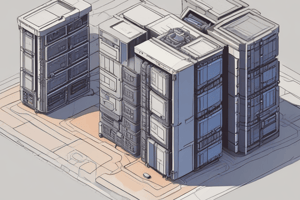Podcast
Questions and Answers
Which of the following is a key advantage of distributed systems?
Which of the following is a key advantage of distributed systems?
- Enhanced reliability and scalability. (correct)
- Reduced communication overhead.
- Simplified programming models.
- Increased complexity in management and security.
In a distributed system, the term 'transparency' refers to making the distribution of resources and services visible to the users.
In a distributed system, the term 'transparency' refers to making the distribution of resources and services visible to the users.
False (B)
Which type of transparency specifically hides the relocation of a resource while it is in use?
Which type of transparency specifically hides the relocation of a resource while it is in use?
- Access transparency
- Relocation transparency (correct)
- Migration transparency
- Location transparency
What is the primary goal of 'middleware' in the context of distributed operating systems?
What is the primary goal of 'middleware' in the context of distributed operating systems?
A key principle for good decentralized algorithms is that 'no machine has a ______ state'.
A key principle for good decentralized algorithms is that 'no machine has a ______ state'.
Which distributed system model involves powerful workstations acting as servers for tasks like file or database services?
Which distributed system model involves powerful workstations acting as servers for tasks like file or database services?
A monolithic operating system structure decomposes functionality into distinct layers.
A monolithic operating system structure decomposes functionality into distinct layers.
Match the following concepts with their corresponding example or description:
Match the following concepts with their corresponding example or description:
Within uniprocessor operating systems, what role does the OS play?
Within uniprocessor operating systems, what role does the OS play?
What is a primary characteristic of a microkernel operating system architecture?
What is a primary characteristic of a microkernel operating system architecture?
Flashcards
Definition of Distributed System
Definition of Distributed System
Multiple connected CPUs working together, appearing as a single coherent system to users.
Advantages of Distributed Systems
Advantages of Distributed Systems
Sharing resources and facilitating communication, offering cost-effective solutions and scalability.
Disadvantages of Distributed Systems
Disadvantages of Distributed Systems
Requiring distribution-aware software, reliable network connectivity, and robust security measures.
Transparency in Distributed Systems
Transparency in Distributed Systems
Signup and view all the flashcards
Open Distributed Systems
Open Distributed Systems
Signup and view all the flashcards
Principles for Decentralized Algorithms
Principles for Decentralized Algorithms
Signup and view all the flashcards
Scaling Techniques
Scaling Techniques
Signup and view all the flashcards
Network Operating System (NOS)
Network Operating System (NOS)
Signup and view all the flashcards
Distributed Operating System
Distributed Operating System
Signup and view all the flashcards
Multiprocessor Operating Systems
Multiprocessor Operating Systems
Signup and view all the flashcards
Study Notes
- The lecture discusses distributed systems, their advantages, disadvantages, transparency, scalability, and various OS models.
Definition of a Distributed System
- A distributed system involves multiple connected CPUs working together.
- It appears to users as a single coherent system, despite consisting of independent computers.
- Examples includes parallel machines and networked machines.
Advantages and Disadvantages
- Communication and resource sharing become possible within a distributed system.
- Economics are improved via the price-performance ratio.
- Reliability and scalability are benefits.
- There is potential for incremental growth.
- Distribution-aware programming languages (PLs), operating systems (OSs), and applications are needed.
- Network connectivity is essential.
- Security and privacy are main concerns.
Transparency in a Distributed System
- Access transparency hides the differences in data representation and how a resource is accessed.
- Location transparency hides where a resource is located.
- Migration transparency hides that a resource may move to another location.
- Relocation transparency hides that a resource may be moved to another location while in use.
- Replication transparency hides that a resource may be replicated.
- Concurrency transparency hides that a resource may be shared by several competitive users.
- Failure transparency hides the failure and recovery of a resource.
- Persistence transparency hides whether a software resource is in memory or on disk.
Open Distributed Systems
- Services are described a priori
- Syntax and semantics are known via protocols.
- Services are specified via interfaces.
- Benefits include interoperability and portability.
- Open systems should evolve and be extensible over time to accommodate new functionality.
- Policy should be separate from mechanism.
Scalability Problems
- Centralized services are a single server for all users.
- Centralized data is a single online telephone book.
- Centralized algorithms perform routing based on complete information.
Scaling Techniques
- Principles for good decentralized algorithms include:
- No machine having a complete state.
- Decisions are made based on local information.
- A single failure does not bring down the system.
- No global clock.
- Techniques:
- Asynchronous communication.
- Distribution.
- Caching and replication.
Distributed Systems History and OS Models
- Minicomputer Model: Early networks where each user has a local machine with local processing but can fetch remote data.
- Workstation Model: Processing can also migrate.
- Client-Server Model: Users have local workstations, and powerful workstations serve as servers.
- Processor Pool Model: Back-end processors handle processing for terminals.
Distributed System Models (contd)
- Cluster Computing Systems/Data Centers: LAN with a cluster of servers and storage used for distributed web servers, scientific applications, and enterprise applications.
- Grid Computing Systems: Clusters of machines connected over a WAN.
- WAN-Based Clusters/Distributed Data Centers: Such as Google, Amazon.
- Virtualization and data center and cloud computing are modern approaches.
Emerging Models
- Distributed Pervasive Systems: features smaller nodes with networking capabilities where computing is "everywhere".
- Home networks, mobile computing with smartphones and car-based PCs, sensor networks, and healthcare applications.
- Sustainability is another design goal.
Uniprocessor Operating Systems
- An OS acts as a resource manager or arbitrator, managing CPU, I/O devices, and memory.
- Provides a virtual interface easier to use than hardware.
- Structure:
- Monolithic with one large kernel.
- Layered design where functionality is decomposed into N layers.
Microkernel Operating Systems
- Microkernel Architecture: Features small kernel and user-level servers that implement additional functionality.
Distributed Operating System
- Manages resources in a distributed system seamlessly and transparently to the user.
- Presents a virtual uniprocessor to users even though it operates on multiple independent CPUs.
- Provides transparency in location, migration, and concurrency.
Types of Distributed OSs
- DOS (Distributed Operating System): Tightly-coupled OS for multiprocessors and homogeneous multicomputers to hide and manage hardware resources.
- NOS (Network Operating System): Loosely-coupled OS for heterogeneous multicomputers to offer local services to remote clients.
- Middleware: Additional layer atop of NOS implementing general-purpose services to provide distribution transparency.
Multiprocessor Operating Systems
- Acts like a uniprocessor OS and manages multiple CPUs transparently.
- Each processor has its own hardware cache, maintaining consistency.
Network Operating System
- Employs a client-server model with a minimal OS kernel and additional functionality as user processes.
Middleware-Based Systems
- General structure of a distributed system as middleware which sits between distributed applications and network OS services.
Studying That Suits You
Use AI to generate personalized quizzes and flashcards to suit your learning preferences.





